

James and the rest of his siblings grew up in Toll Gate, Ritchie County, West Virginia where James attended Pennsboro High School. When James was about seventeen years old the family moved to Dog Run - near to James's original roots at Salem. While in Salem, James was employed at the Mowery Service Station for several years.
Army life was not too unpleasant for James, as he mentions in several of his letters home to his parents: "I am getting along fine, and getting plenty to eat...This is beautiful country over here. The people sure know how to farm." He later wrote, "I am getting along just fine, so don't you fellows worry about me. I can take care of myself."
Even though he was always anxious to let everyone know that he was doing well, James was always very concerned about his family and everything that was going on at home.
| On April 11, 1944, he inquired, "Where is Denzil at now? Or do you know? Have you heard anything from Gene yet?...Is Ruth and Linda getting along alright? I worry about them sometimes, she wouldn't tell me if she was sick, so that I wouldn't worry about them." In another letter, James wrote, "Do you still have your cow? Boy, I could sure enjoy a qt. [quart] of milk right now... How is Bobby getting along with his new job? Tell him to do good work and take care of that job and he will work himself into a good position...How is Freda and the baby getting along?" James looked forward to returning to West Virginia to visit his newest relatives. On September 12, 1944, he wrote, "How is Irene and her new baby getting along? Here I have been an Uncle three times since I left. I will have lots of nephews and nieces to get acquainted with when I get home." | 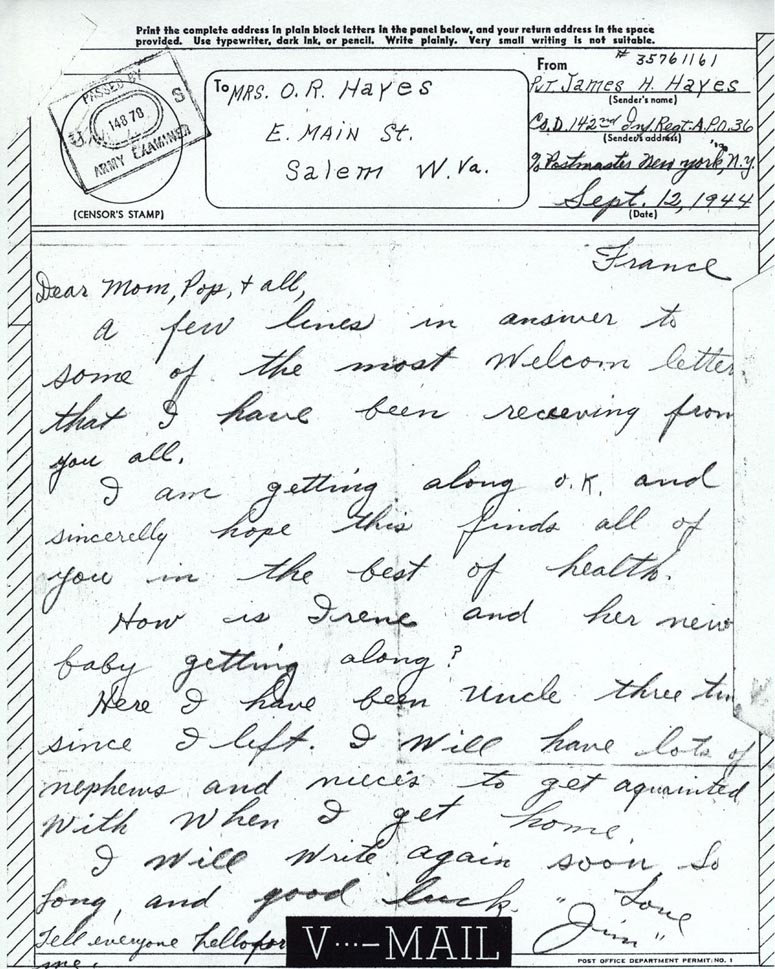 Letter from James Hayes |
While James was serving gallantly in the European Theater of operations, his younger brother Gene was defending freedom in the Pacific.
Before leaving the country, Gene got to spend some time in California. He took a moment while he was on the train in Chicago to write his mom and dad to tell them a little bit about his coming adventures overseas: "They gave us $6.75 before we left fore Calif., we may stay their a month and we might get to leave just as soon as we get there. If the boat has come it will take 42 days to get to the Phillipines Is. from Calif. I bet their will be a bunch of sea sick boys on the boat."
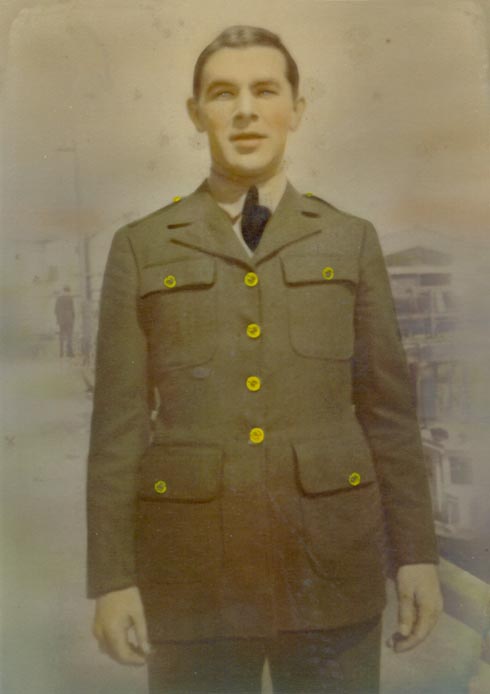 Gene Hayes |
Gene liked to stay in touch with his family from the Philippines, and he frequently wrote letters home to keep up on events and to speak of his experiences. On October 7, 1941, he wrote, "I am feeling good and hoping every one the same. Take care of your health, hoping to see every [one] soon. Wishing every one a Merry Xmas." Gene's happier times in the Philippines were to be all too short lived. |
 Corregidor |
Gene was thrust into the heat of war when the Japanese waged all-out air war on the islands on December 8, 1941. On December 22, 1941 the Japanese ground forces landed below Manila, and soon the American and Filipino forces under General Douglas MacArthur (of which Gene was a part) were forced to retreat to Manila Bay. After the President ordered General MacArthur to leave for Australia, the rest of the troops remained behind to stand against the enemy. Even though these brave men led a gallant effort, they were no match for the Japanese at that point. Gene was captured by the Japanese as a prisoner of war when Corregidor fell and General Wainwright was forced to surrender his troops on May 6, 1942. Although his status was first listed as "Missing in Action," it soon was determined that he was being held in a POW camp in Japan. |
Gene spent three long years as a prisoner of war under the Japanese. During this time the Hayes family received several letters of encouragement, including one from Congressman E. G. Rohrbough. In May, 1944 the Office of the Provost Marshal General even sent the Hayes family specified instructions on how they could write to Gene while he was being held captive.
In late 1944, Gene was transferred to the Osaka Camp, southwest of Tokyo, Japan. This camp would soon become part of the Nagoya Prison Camp system. The prisoners at this camp were used primarily to mine for zinc and lead. It was at this camp that Gene gave his ultimate sacrifice for his country. Gene died of pneumonia as a prisoner of war on April 17, 1945. This sad fact was confirmed by a letter to the Hayes family from Maj. Gen. Edward F. Witsell, Acting The Adjutant General of the Army, on November 1, 1945.
| On November 26, 1945, General of the Army Douglas MacArthur, Supreme Commander of the Allied Forces in the Pacific, sent .a touching letter to the Hayes family in which he summarized the heroic efforts that Gene exhibited over the years of his service, and the sympathy that he felt for the Hayes family. |  Letter from General Douglas MacArthur |
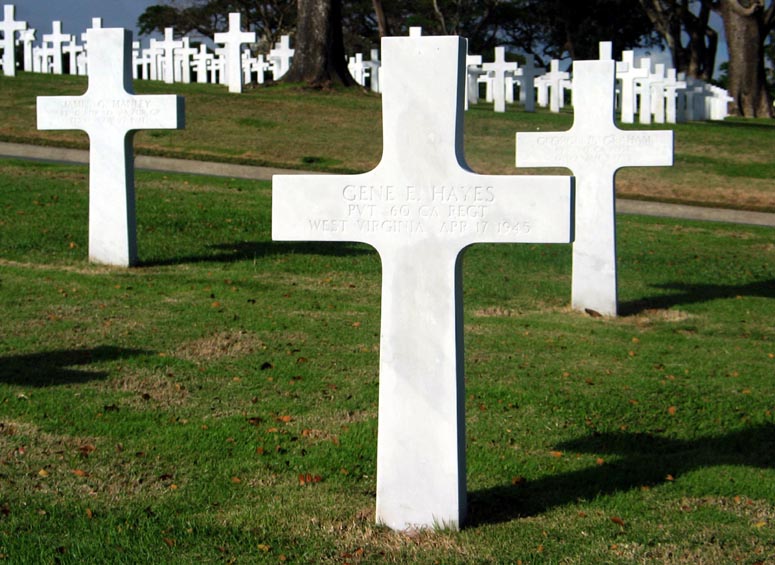 Grave marker of Gene Edward Hayes |
In recognition of the honorable service that these brothers performed in World War II, and for their ultimate sacrifice, James was awarded the Purple Heart and both James and Gene had their names inscribed on the original engraving of the West Virginia Veterans Memorial. Both brothers are also buried in two of our American Battle Monuments Commission administered cemeteries. James is buried in Plot B, Row 27, Grave 30 at the Epinal American Cemetery in Epinal, France. Gene is buried in Plot D, Row 2, Grave 373 at the Manila American Cemetery in Manila, Philippines. The United States of America and the State of West Virginia are eternally grateful for the service of these fine men. Their sacrifice will never be forgotten. |
| As an interesting footnote to the story of James and Gene Hayes, there was a recent example of how those who died for our freedom will never be forgotten. The Boy Scouts of America have two troops in the Philippines. Troop 352 is part of the Far East Council. Over Christmas 2003, this troop was having a camp-out on the island of Corregidor an activity that the troop tries to do every year. During the camp-out the Boy Scouts look for artifacts from World War II and normally find bullets or household items. During this particular camp-out, one of the boys found a "dog-tag" from a US Army vet that served on the island. This dog-tag belonged to Gene Edward Hayes. |  Dog-tag of Gene Hayes |
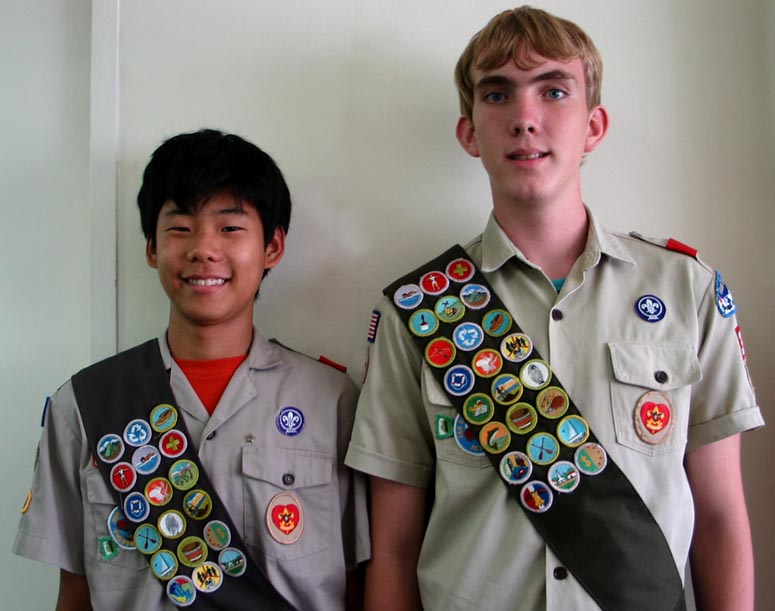 Jonathan
Ma and Carl Schwarze Jonathan
Ma and Carl Schwarze |
Jonathan Ma was the Boy Scout who found the tag. He was a ninth grader who just held his Eagle Court of Honor to become an Eagle Scout on May 17, 2004. Jonathan and the rest of his troop graciously sent the tag to the West Virginia State Archives so that it could be properly presented to Gene's next-of-kin. It was soon discovered that much of Gene and James's family still resides in Salem. The State Archives and the Salem Chamber of Commerce have made arrangements to have the tag properly returned to the Hayes family. |
 |
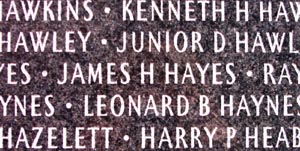 |
West Virginia Archives and History welcomes any additional information that can be provided about these veterans, including photographs, family names, letters and other relevant personal history.